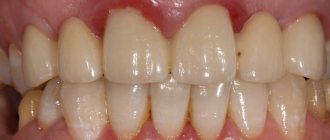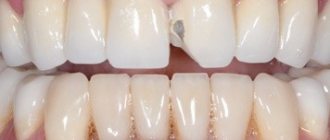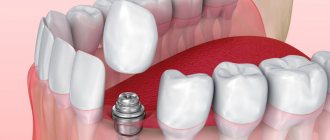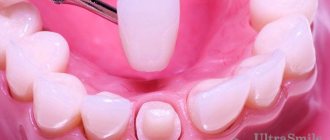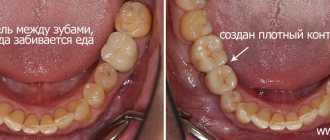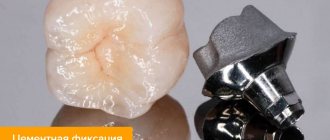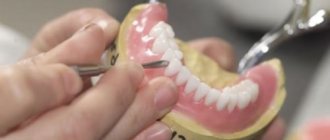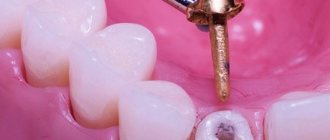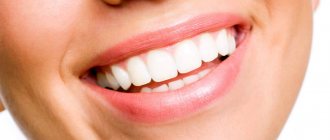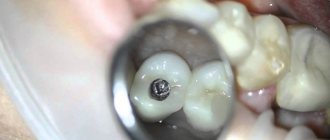What types of prostheses are there, which ones are better to install?
Crowns are fixed to the visible part of the element using a special dental compound. Prosthetics with crowns allows you to simultaneously restore chewing function and the anatomy of the dentition.
Teeth crowns differ in material and, accordingly, in price. To decide which crowns are best placed in a particular clinical case, you should outline the pros and cons of each type of prosthesis
Plastic crowns
Such products are used as temporary crowns. They are lightweight, quick to manufacture and inexpensive. The structures are fixed to ground teeth or implants (while the permanent prosthesis is being prepared).
The mission of temporary crowns is to evenly distribute the chewing load on the dentition, while reducing the risk of developing bone atrophy in the jaw and further accelerating the process of getting used to the permanent prosthetic structure.
Metal-plastic crowns
The most inexpensive option for prosthetics. The crown is based on a metal alloy (cobalt, chromium, nickel). To give the prosthesis a natural appearance, the base is covered with a layer of plastic. In case of minor chips in the material, the product can be repaired directly in the patient’s mouth.
Metal-plastic structures are not strong enough - they can last a person up to 3 years. Over time, products lose color, slightly increase in size, and can cause allergies.
Metal ceramics
Metal-ceramic crowns are the true “golden mean” - the products are quite reliable and aesthetic. The surface of the prosthesis is ceramic, and the base is a metal alloy.
When making dentures from precious metals (gold, silver, palladium), you can count on a more natural appearance of the structure. In this case, the metal base will not give off a grayish tint through the coating, as is the case with conventional metals.
The relatively low price of metal-ceramic prosthetics with its acceptable functional and aesthetic indicators makes this method of tooth restoration the most popular. However, before making a choice in favor of metal ceramics, it is worth considering the risk of developing an allergy to metal, as well as the minimal likelihood of chipping the ceramic coating.
Metal crowns
This type of prosthesis is less popular these days. The product looks like a metal cap that is placed on a damaged tooth or titanium root. The strength of these crowns is enviable. A significant disadvantage of such products is their unaesthetic appearance: metal in the oral cavity is difficult to hide from prying eyes.
The denture is made in a dental laboratory. The basis is steel, titanium, as well as gold and platinum. In dentistry, there are two types of metal crowns:
- stamped. These are standard caps that are given an individual shape in the patient’s mouth. The products have thin walls, so they wear out quickly and are very rarely used in practice;
- cast. The designs are prepared on the basis of personal casts. This technique makes it possible to produce dentures that fit perfectly to hard tissue, eliminating the spread of bacteria in the space between the denture and dental tissue.
In the process of manufacturing metal crowns, spraying technology is often used. The material for these purposes is chosen at the request of the patient (gold, zirconium dioxide, plate).
Metal-free crowns
This type of crown has the highest aesthetics - it is very difficult to distinguish them from natural teeth. The following materials can be used in the production of prostheses:
- porcelain or pressed ceramics. The most attractive looking crowns. They are inferior to their analogues in strength, but are absolutely safe for the patient - they have a high biocompatibility index;
- zirconium dioxide. A durable material that is superior to alternative options in aesthetics - teeth with such crowns look like natural ones in the mouth. Other advantages of zirconium dioxide crowns include: safety, resistance to breakage, long service life;
- aluminium oxide. This material is slightly lighter than zirconia, making it most preferred when restoring anterior teeth. Products made from aluminum oxide are hypoallergenic and do not change their shade.
Alternative Treatment Options
Some doctors believe that straightening crooked teeth with crowns is not the best idea. The method is quite radical, and it is better to use it only in extreme cases, for example, when a tooth, in addition to curvature, has other defects, for example, it is severely damaged by dental disease or injury, and the question arises of how to extend its service life. Or if the patient has a disease such as systemic enamel hypoplasia.
If the choice in favor of crowns is based only on the fact that you do not want to wear braces, then we recommend considering more preferable options for correcting minor bite defects.
Composite restoration
This is the fastest and least expensive option when you want to correct 1-2 teeth with slight deformations located in the smile area. For example, if one of them is slightly offset in relation to the others, then the doctor can use a composite to increase its thickness so that it becomes symmetrical relative to its “neighbors”. In this case, the enamel is not ground or drilled with a bur, but only slightly sanded for better adhesion to the filling material.
The advantages of the method are that, even if you later decide to correct your bite with braces or other orthodontic devices, a specialist will easily remove the composite without consequences for hard tissues.
Veneers and Lumineers
Thin overlays, no more than 0.7 mm thick, can perfectly mask three, several crooked or “short” teeth in the smile area. Moreover, to install them, the doctor will not grind hard tissues from all sides; he will only need to dissect the outer frontal area. To fix the lumineers, it will be possible to get by with only minor grinding of the enamel, which is necessary to ensure that the linings stay firmly in place.
Installation of veneers and lumineers, like crowns, does not require several years of treatment. Overlays allow you to get a quick, comprehensive result and hide all external defects, from slight curvature to unsightly enamel color. Plus, they also perform a protective function, protecting sensitive tissues from the temperature of food and bacteria.
Aligners
Unlike braces, they are soft, transparent and removable; they can always be removed from the mouth for eating and hygiene procedures. During use, they are more comfortable - this is important information for those who are thinking about how crowns correct teeth only because they find wearing braces very inconvenient.
Another advantage of aligners: they, unlike crowns, veneers and lumineers, do not mask the defect, but treat it.
Trainers
Suitable for correcting minor malocclusion pathologies, including affecting the main causes of its occurrence. Namely, they help to eradicate bad functional habits that contributed to the development of deformity. For example, trainers will help the tongue take the correct position in the mouth and help form the correct type of breathing and swallowing. The devices are often used for children, but are sometimes recommended for adults as well.
Comparative characteristics of different types of dental crowns
The table below shows the characteristics of popular types of dental crowns. This information should be taken into account when choosing crowns for the front or chewing teeth.
| Comparison parameter | Metal ceramics + gold, silver, palladium | Metal ceramics + nickel, chrome | Pressed ceramics | Zirconium | Aluminium oxide | Metal-plastic |
| Possibilities of prosthetics | ||||||
| Single restoration | + | + | + | + | + | + |
| As part of a dental bridge | + | + | + | + | + | + |
| For metal intolerance | + | — | + | + | + | — |
| For sore gums | + | — | + | + | + | — |
| For sensitive enamel layer | — | — | + | + | + | + |
| Qualitative characteristics | ||||||
| Possibility of fixing without turning | — | — | + | — | — | — |
| Probability of chipping (scale - 5 points) | 2 | 3 | 3 | 1 | 1 | 5 |
| Maintaining aesthetics in % | 80 | 70 | 100 | 100 | 100 | 20 |
| Production | ||||||
| Manual technique | + | + | — | — | — | + |
| Computer modelling | — | — | + | + | + | — |
Can the patient himself understand that it is time to replace the crown?
Certainly! There are a number of signs, the presence of which should give cause for concern.
- The most common is crown edge exposure , when the gingival margin rises and the tooth root becomes visible (“gingival recession”). In this case, root caries may develop, that is, the tooth may be destroyed.
Photo 2.2. The initial stage of exposure of the roots of the teeth under the crowns.
Photo 2.3. The advanced stage of exposure of the roots of the teeth under the crowns.
- Inflammation of the gums around the crown , which manifests itself in redness of the gums, swelling, and bleeding when brushing.
Photo 2.4. Inflammation of the gingival margin of teeth under crowns, associated with inaccurate marginal fit of the crown to the tooth and with a violation of the biological parameters of tooth restoration.
- The appearance of crown mobility . Patients often say that the crown or bridge is “fixed.” This happens especially often when several crowns are combined (some of the crowns of the bridge have become uncemented, while the rest are still holding together).
- The appearance of an unpleasant odor or taste in the crown area.
- Food getting stuck between crown/crown and tooth.
Important! All of the above signs are a mandatory reason to visit the dentist.
Which crowns are best for back teeth?
The lateral teeth bear the basic load, so for their reconstruction it is worth using the strongest prosthetic products. Aesthetics in this case are less important. However, not any unaesthetic material (metal) will be compatible with soft tissues - this is also worth taking into account when choosing crowns for molars.
Metal prostheses are reliable and inexpensive, they very rarely break. The disadvantages of prosthetics with metal crowns are a low level of aesthetics and a high risk of developing allergies.
You can solve the problem of material incompatibility with fabrics by choosing products made of precious metals (gold-platinum alloy) for installation. They are safe and non-toxic. However, the price of a crown will be comparable to the cost of a ceramic product.
The most preferred option for prosthetics of lateral teeth remains metal-ceramics. This choice of most patients can be called justified, because a metal-ceramic crown is an excellent ratio of price and quality. Compared to a metal structure, such a prosthesis is inferior only in strength (there is a risk of chipping the ceramic coating). Blueness of the gums, which is formed as a result of contact between metal and soft tissues, is not embarrassing, since we are talking about prosthetics in the area of chewing teeth.
It is not recommended to place all-ceramic structures on teeth, since they are not very durable - there is a high risk of chipping and breaking. An alternative to classic ceramics can only be E-max glass ceramics - a durable analogue at a higher price.
Products made from zirconium dioxide are the strongest and most durable, which is why they are often recommended for use in dental restoration. However, in this case, it is preferable to use exclusively monolithic zirconium crowns (the veneer may break off).
Disadvantages that everyone needs to know about
Is it possible to correct crooked teeth with crowns? Structures cannot be treated. They only mask the defect, make it possible to achieve external attractiveness, but do not correct the cause of the pathology, i.e. broken bite. Therefore, their installation is advisable only if the anomaly is minor and does not threaten the health and functionality of the maxillofacial apparatus.
Another significant drawback: installing a crown is an irreversible process. Underneath it, you need to sharpen and depulp the tooth, and after removing the structure, it may even need to be removed. After all, a depulped unit is destroyed much faster than one in which there is living pulp. And in this regard, braces and any orthodontic devices benefit, because... after a course of treatment they can be removed; they do not require such sacrifices, although, of course, you have to wait a long time to get a positive result.
Important! Crowns do not allow you to change the incorrect location of the roots of the teeth and do not eliminate the cause of the anomaly. Therefore, it would be more correct to say that they do not straighten teeth, but only quickly restore their natural shape and color, and correct only individual defects.
Some patients believe that if they install a crown, they will not be at risk of caries or any other dental disease. However, this is a misconception. An inflammatory process can also develop under the structure if the canals were poorly treated, it was installed incorrectly, or due to insufficient hygienic care for the oral cavity.
Which crowns are best placed in the smile area?
When fixing crowns on the front teeth, much attention is paid to the aesthetics of the result. The main task of the prosthesis is to be strong enough and not stand out against the background of natural teeth. When restoring the upper and lower dentition, identical design options are used.
Today, metal crowns are not placed on the front teeth. This statement is true both for products made of ordinary metals and precious ones.
Metal-ceramics is a good-priced, but aesthetically controversial, prosthetic option. The metal base of the structure is visible through the ceramics; over time, a bluish rim forms at the site of contact of the gums with the metal. To eliminate the second drawback, dentists offer to install metal-ceramic crowns with shoulder mass on the front teeth. However, this type of prosthetics is more expensive.
Prostheses made of medical porcelain or pressed ceramics are the best option for prosthetics of the frontal area. The crowns look good and are able to withstand the load placed on this area. The price of the products is quite affordable.
Constructions made of zirconium dioxide (aluminum oxide) should be installed if the color of the teeth in the smile area is significantly changed. In this case, a zirconium frame and porcelain lining will be the best option. The cost of such prosthetics is comparable to the price of ceramic crowns.
Can I use dental floss?
If you have any dentures in your mouth, you should either refuse floss completely or use it too carefully. The crowns are fixed in such a way that natural micro-gaps between them are preserved, which require cleansing. However, when flossing, you should not make vertical movements - only horizontal ones. That is, you need to insert the thread not from the cutting edge, gradually moving towards the gums, but place its tip directly into the gap - make several horizontal movements and remove it in a similar way.
Do not use the prosthesis if it has a chip or crack - try to see a doctor as soon as possible to restore the integrity of the crown/inlay or for a prompt replacement. Otherwise, there is a high risk of developing inflammatory processes under the prosthesis.
Service life of dental crowns made of different materials
The most short-lived are temporary crowns on teeth (plastic). In second place in terms of durability are products made of metal-plastic. The longest service life of structures is 5 years. However, patient reviews “speak” of premature darkening and deformation of the crowns.
Metal-ceramic dentures, which are successfully fixed to both the front and chewing teeth, usually last about 10 years. Artificial teeth made of ceramics remain the same in appearance and functionality for 10-15 years.
Metal crowns made of metal alloys last a long time and last at least 15 years.
Expensive materials - zirconium dioxide and aluminum oxide - last up to 20 years. The long service life justifies their high cost.
The service life of prosthetic structures is determined not only by the quality of their manufacture, but also by the care they are provided after installation.
What diet should you follow?
A lot depends on the original condition of the tooth to be restored. So, if the root is strong, approximately half of the tissues of the coronal part are preserved, and the prosthesis itself is installed correctly and professionally, there are no obvious restrictions in terms of load. Stump tabs, which are also used to strengthen the root system, fit very tightly, hold securely and do not require any special changes in nutrition. But if, for example, prosthetics were performed on a pin, the chewing pressure on the tooth must be reduced, since it can lead to displacement of the pin, and subsequently the crown.
In general, recommendations for any type of prosthetics from a nutritional point of view would be as follows:
- limiting the consumption of drinks high in caffeine (tea, coffee) and coloring pigments (wine, beets), especially if you have plastic and metal-plastic crowns that absorb dyes from food and drinks,
- Food that is too cold or too hot should be eaten with great caution - it can lead to cracks and chips of materials, and disruption of their adhesion (fixation). It is also impossible, for example, to immediately drink hot tea after cold ice cream - sudden temperature changes can again provoke the formation of cracks and destruction of dentures, weaken the effect of the fixing adhesive,
- Despite the fairly high strength of crowns and inlays, you need to protect them from excessive loads - it is better to first cut solid food into small pieces,
- teeth with crowns should not be used to open the shells of nuts, such as pistachios,
- If you have dentures, it is recommended to avoid viscous and stringy foods, namely chewing gum and toffees, which can stick to crowns or inlays, and with excessive load and gradual deterioration of the fixation of the prosthesis can lead to its loss.
First of all, crowns that have an external coating that can break off need to be protected from mechanical loads - made of metal-plastic, metal-ceramic or zirconium coated with ceramic.
How to properly care for dental crowns
Following simple recommendations for caring for dentures will help extend the “life” of dental crowns. Regardless of the material of manufacture, dentists advise patients to provide the structures with the following care:
- brush your teeth using a toothbrush and toothpaste twice a day (morning and evening). Clean not only teeth, but also cheeks and tongue from plaque;
- use a paste of medium (soft) abrasiveness. Large particles in pastes harm not only the enamel of natural teeth, but also the surface of dentures;
- Clean spaces between teeth using dental floss. As an alternative, you can use a irrigator or a special brush;
- when wearing a bridge, it is good to clean the intermediate crown;
- rinse your mouth with mouthwash or running water after each meal;
- limit the consumption of foods with dyes - coffee, black tea, chocolate, red wine, etc.;
- do not overload dentures - do not eat too hard foods, get rid of bad habits (do not open lids with your teeth, do not chew a pencil, etc.);
- Avoid sudden temperature changes that can cause chipping of the ceramic layer.
For preventive purposes, the patient is recommended to visit the dentist every six months; at the same interval, the patient is recommended to undergo professional cleaning of the oral cavity.
What hygiene products are needed and can be used?
What hygiene products are needed and can be used?
| NAME | DESCRIPTION |
| Toothbrush | The bristles should be soft or medium hard. Too hard ones can damage the material and leave small scratches on it, in which plaque will accumulate. The use of an ultrasonic or mechanical brush is allowed, but it is very important to carefully select attachments - they should not have plastic elements (often used to better clean or whiten teeth). |
| Toothpaste | It is better to use prophylactic toothpaste WITHOUT abrasive substances - they can damage the materials. |
| Irrigator | It will allow you to remove food debris from the interdental spaces, especially if several crowns are installed in a row or dental bridges are present - in such a situation, a stream of water will remove food debris from under the structure. |
| Mouthwash | It should be selected in accordance with existing oral problems - for example, to combat gum inflammation, to strengthen enamel or to prevent plaque accumulation. That is, regardless of whether you have dentures or not. |
Reviews from doctors and patients
Dentists consider dentures with crowns to be an excellent way to restore significantly damaged elements. Doctors note a significant advantage of this solution - it is an opportunity to prevent the destruction of a “dead” tooth or even preserve a “living” unit (if it is partially destroyed). This method cannot be called universal only because it has a number of contraindications, one of which is root damage.
Patients, for the most part, speak positively about prostheses of this type. They note the rapid restoration of functionality and aesthetics of the series, ease of use and durability of the prostheses.
What are the contraindications
Correcting crooked teeth with crowns will not work if you have serious malocclusions that affect the entire jaw and affect its functionality. In this case, you cannot do without orthodontic appliances or even their combination with surgery.
Important! Why can’t prosthetics be done with crowns if, for example, there are anomalies not in 1-2, but in a whole number of teeth? The restorations will be unstable and short-lived, and their functionality will also be very mediocre. Thus, due to improperly distributed load, structures can chip, break, and even move apart, forming gaps between the teeth.
Installation is contraindicated for patients with inflammation of periodontal tissues, leading to loosening of the row. For example, with periodontitis and periodontal disease. Also, prosthetics should not be performed on people with bruxism or neuropsychiatric disorders.
Why patients choose veneers
It is logical to level something using leveling devices specially created for this purpose. In dentistry, these are definitely braces. Only they are able to correct the curvature of individual teeth or a row (both rows), eliminating this problem forever. But braces have a significant drawback: they require considerable time to use. Patients do not want to walk around with foreign “pieces” in their mouth for years. And invisible braces are expensive.
But there is a way to change everything almost immediately; in two weeks your teeth will be as good as new. And not only smooth, but also the desired whiteness. Tempting? Veneers, however, also have a drawback - to install them, you will have to ruin your own living teeth, even if not ideal, by grinding them down to the required size. But what does such a “trifle” mean compared to a white-toothed, even smile!
Veneers: before and after photos
Correcting crooked teeth with veneers
It’s decided – patients choose veneers. But it's not that simple. In many cases of crooked teeth, it is simply impossible to correct it with onlays.
You will need braces:
- if the teeth are in a crowded position;
- if there are wide gaps between the teeth;
- if the shift in the dentition is significant;
- if the curvature of the teeth is not one-sided, but they are all directed in different directions.
Correcting crooked teeth with braces
Veneers can be installed:
- How are veneers placed?
- with slight curvature of the dentition;
- if the crowding is minor;
- if there are gaps between some teeth;
- if there are chips or chips in the enamel.
Veneers can help correct small defects
Is it possible to carry out professional hygiene with crowns?
Both teeth and any dentures require high-quality hygiene. Once or twice a year, have your teeth cleaned with an ultrasound. But Air Flow is prohibited in the presence of multiple crowns, since the drug contains abrasive particles that can damage the smooth surface of the dentures. In such a situation, you should definitely warn the doctor about the presence of crowns or bridges - if there are few of them, you can simply bypass them and carry out Air Flow cleaning in another area.
Braces or veneers - what to choose?
You can straighten your teeth with braces and veneers. However, it is impossible to compare systems, since the former correct malocclusions by moving teeth to the correct position, while the latter only mask aesthetic defects and correct the shape.
For minor crooked teeth, a specialist will most likely recommend the installation of veneers, and in the case of more serious pathologies, correction with braces.
| Braces | Veneers |
✔ Corrects dental abnormalities for life ✔ Needs careful care ✔ Have an adaptation period |
✔ Defects are corrected in one or two procedures ✔ Installed for a period of no more than 10 years ✔ There are no special indications for hygiene ✔ Doesn’t require a lot of getting used to |
In terms of price, the braces system is more profitable than prosthetics with veneers. The cost of installing orthodontic devices in Moscow clinics starts from 65,000 rubles. A ceramic onlay for one tooth costs from 34,000 rubles, and in most cases a minimum of four microprostheses are required. The most affordable are composite veneers (from 3,000 to 8,000 rubles), but these structures cannot be called durable.
Method for correcting bite
With a correct bite, the upper teeth, protruding forward, should cover the lower elements by a third. A practical way to correct an overbite is to install permanent crowns.
Crown placement is a type of prosthetics. They are applied to the treated tooth surface. Purposes of crown placement:
- correct crowding;
- restore the anatomical shape of teeth;
- correct chewing and speech disorders;
- give a pleasant look to your smile.
The placement of crowns gives the jaw row the correct shape, which ensures normal jaw movement.
Why do teeth grow crooked?
Often children inherit not the best traits of their parents. If parents have a similar problem, the anomaly is likely to be passed on to the child. In addition to genetic predisposition, the deformity is provoked by a lack of vitamins and microelements in the diet of the expectant mother. The lack of solid food in the baby's menu, frequent mouth breathing, congenital anomalies - all this affects the formation of the dentition.
One of the common causes of malocclusion is thumb sucking in childhood. At school age, the child switches to sucking pens, pencils, and begins to bite his nails. Injuries and poor oral hygiene can also cause crooked teeth. Early loss of baby teeth can lead to crooked permanent teeth.
Problems with wisdom teeth
Initially, the dentition may be straight. If your dentist notices that it has started to become crooked, wisdom teeth may be the cause. Third molars displace adjacent teeth. But even after their removal, the dentition will no longer straighten on its own.
Often the eruption of eights occurs at the age of 20-25. If they have nowhere to erupt, they move their neighbors who are located in front. If before the appearance of figure eights the dentition was straight, then after their appearance orthodontic treatment may be necessary.
At a consultation appointment in our clinic, the doctor will assess the condition of the oral cavity. If necessary, he will remove third molars under anesthesia. You will not feel pain or discomfort. If you're self-conscious about your smile, it's time to make an appointment with an orthodontist.
Need some advice?
Enter your phone number and we will give you a free consultation
I want a consultation
*By making an appointment you consent to the processing of your data
Loss of teeth
When removed, teeth tend to fill the void and take up free space. By bending and moving, they create the basis for the improper development of others. This causes crowding.
In this case, the permanent tooth, which no longer has a place where it should erupt, follows the path of least resistance. He takes a place that is convenient for him. The cause of abnormalities in adults is injury. Under the chewing load, the dentition constantly shifts towards an empty space. Even if your bite was perfect before, in this situation it will deteriorate.
Underdeveloped dental system
The distant ancestors of mankind had no problems with the dental system. This is because they ate solid food that was not thermally processed. Due to the fact that people now eat freeze-dried food, the dental system does not develop as it should. As a result, the number of teeth remains the same, and the jaws do not fully develop.
This leads to crowding and the development of malocclusions. A person should eat solid food from childhood. Prolonged sucking of pacifiers negatively affects the formation of the dentition system.
How to straighten teeth with braces
Braces are installed in stages. Preparation and diagnosis are especially important. The doctor conducts an examination, comprehensive diagnostics, and makes impressions of both jaws. At the first stage, contraindications to the procedure are determined. If there are no restrictions, then the dentist performs sanitation of the oral cavity. Professional cleaning and treatment of carious teeth is a prerequisite before fixing structures.
When installing sapphire or ceramic braces, you must first whiten your teeth. The corrective action is carried out due to external pressure. The main role is assigned to the rigid arc. Therefore, doctors regularly replace one arch with another. Depending on the complexity of the deformity, correction takes up to 1.5 years.
Types of bracket systems:
- metal - suitable for the most severe deformities; metal clasps provide more intense pressure, which reduces the duration of correction;
- ceramic - made of polymer based on aluminum oxide, due to this the systems are transparent and invisible;
- sapphire - made from a mineral that is grown under artificial conditions, such systems are hypoallergenic, durable, and resistant to coloring from food dyes.
Installing braces at the Propricus clinic will relieve you of pathologies of the dental system. Dental doctors begin treatment only after a comprehensive diagnosis. All changes and nuances are agreed with the patient. If any contraindications are found, the doctor will suggest you the most appropriate treatment.
When choosing sapphire models, keep in mind that this is the most expensive treatment. Metal systems are the most affordable correction method. To reduce costs, choose a turnkey braces installation service.
WHY DO YOU NEED TEMPORARY CROWNS?
Usually, before installing a crown or prosthesis, the tooth needs to be ground, and only after grinding can impressions be taken and the manufacture of dentures begin. A ground tooth looks very unsightly and causes both aesthetic and psychological discomfort to the patient. To restore the aesthetics and functionality of the dentition, temporary, or provisional, crowns are used. They are especially relevant for the front teeth. However, plastic crowns not only mask visual defects in the dentition. They perform several more very important functions: • Temporarily restore the function of a ground tooth; • Allows you to maintain normal diction; • Do not allow infection to enter the tissues of the prepared tooth; • Prevent gum tissue from growing onto the tooth to ensure normal installation of a permanent crown; • Allow a person to quickly get used to a permanent crown; • Firmly fix the tooth and prevent it from moving to the sides or staggering; • Maintains bite, preventing neighboring teeth from taking up free space; • If a tooth is ground down without removing the nerve, it becomes very sensitive to temperature and chemical stimuli, which can cause pain. A temporary crown protects such a tooth.
